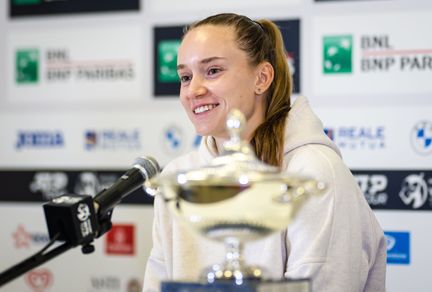ROME -- Marketa Vondrousova, a former Grand Slam finalist and Olympic silver medalist with arguably the finest drop shot in women's tennis today, frequently finds herself overshadowed.
Undeterred, the unassuming Czech player remains unfazed.
"Not for people who know," she said after a practice session at the Internazionali BNL d'Italia, where she was a semifinalist in 2020 and where she will take on former US Open champion Bianca Andreescu in the second round on Friday. "It's more for me to prove to myself than for other people."
In any case, Vondrousova understands why she has yet to fulfill the talent she displayed as a former junior No.1 who won the second Hologic WTA Tour event she entered as a 17-year-old, at Biel in 2017. Time and again, her momentum has been stalled by ill-timed injuries and long layoffs.
Just after winning her first WTA match at Prague 2016, a left elbow injury sidelined her for six months. A month after reaching her first Grand Slam final at Roland Garros 2019, surgery on her left wrist forced her to sit out another six months. And last year, a second wrist surgery -- for a different issue -- took another half-year away.
Even with two significant victories against Ons Jabeur this year, Vondrousova's ranking remains at a modest No.70.
"I'm kind of used to it," Vondrousova said when asked about her permanent state of comeback. "I'm back without pain now, that's the important thing."
This time around, she had some happy distractions. She added to her growing collection of tattoos, some of which have a deeper meaning -- such as those she shares with younger sister Julia -- and some of which simply please her aesthetically.
Last July, Vondrousova married longtime partner Stepan Simek at Chateau Mcely, two hours from Prague. Her wrist cast came off a week before the wedding.
"At least I had something to be happy about," she said. "I wasn't depressed that I couldn't play, because we had the wedding to plan. It was perfect timing, actually."
The time off also gave Vondrousova a rare extended period at home with Simek and their pets, Brownie the pug and Frankie the Sphynx cat. (Frankie was a post-lockdown addition to their family, and the unusual choice of breed was down to Simek's desire for a tidy apartment.) Simek, who works in IT, doesn't travel with Vondrousova often, so it was an opportunity to have a more conventional relationship.
"We've been together eight years, since I was 16, but we weren't used to being together all the time," she said. "It's important for a relationship to actually try to be with each other every day."
The extended injury layoff sometimes seems like an unfortunate rite of passage for tennis players. Former US Open champion Emma Raducanu is about to embark on it this year after three surgeries on her wrists and ankle. Earlier this week, Iga Swiatek and Jessica Pegula also spoke about the challenges they faced after long periods off court earlier in their careers.
Swiatek, who missed eight months in 2017 with an ankle surgery, said that she feared she wouldn't come back.
"I was a teenager and I thought I'm not going to play tennis anymore," Swiatek said. "It's not like I always knew I was going to be a pro. Also, there was the issue of if we're going to have money to continue, to start [again] from the beginning. It's something that suddenly may change your life path."
For Pegula, her two post-surgery layoffs were periods where she learned a lot about herself. She consumed sports autobiographies and realized how committed she was to tennis.
"Anyone that tries to tell you it's fun, it's not," Pegula said. "You have to embrace the suckiness of it. To get through it and appreciate that I'm able to go through this rehab and find other ways to get better."
Both Vondrousova and Pegula came out of rehab more in tune with their bodies. Pegula hired a new trainer 10 months after her hip surgery and began to focus more on mobility work and becoming "a lot more professional" about warmup and recovery.
"I always worked hard when I was in the gym, but sometimes it's not always working hard in the gym," she said. "It's how you're preparing for your matches, for your practices, how your recovery is going after every single match."
Vondrousova did not overhaul her training in the same way but has become more mindful of overexerting herself.
"If I feel like I'm tired, I'll play less," she said. "Your body is telling you to stop. It's not good to play more than you can manage."
This also applied to the comeback process itself. For Vondrousova, it was crucial to take her return slowly in order to preserve her finesse-heavy technique. When her cast was taken off, she found she had lost the power in her shots, so for three weeks she practiced solely with soft children's balls.
Only after three months of hitting with normal balls did she resume competition, and she made her return to lower-level ITF events at the end of 2022 before attempting the main tour this year.
"It's important to have a good team around you who will let you start slowly and not expect you to play big matches or to play great from the beginning," Vondrousova said. "For me, I was so happy to be back on the court that I enjoyed it more. The one good thing about the surgeries is that you feel grateful to be back. It makes you realize how much you love tennis."
